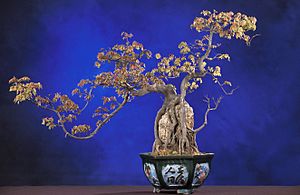Penjing facts for kids
Quick facts for kids Penjing |
|||||||||||||||
|---|---|---|---|---|---|---|---|---|---|---|---|---|---|---|---|

Penjing in root-over-rock style on display at the Chinese Penjing Collection of the National Bonsai and Penjing Museum in Washington, D.C.
|
|||||||||||||||
| Chinese | 盆景 | ||||||||||||||
| Literal meaning | tray scenery | ||||||||||||||
|
|||||||||||||||
| Alternative Chinese name | |||||||||||||||
| Chinese | 盆栽 | ||||||||||||||
| Literal meaning | tray plant | ||||||||||||||
|
|||||||||||||||
Penjing (say "pen-jing"), also called penzai, is an ancient Chinese art form. It's all about creating tiny, beautiful scenes of nature in a pot or tray. Think of it like making a miniature landscape or a small, perfectly shaped tree that looks like it's from a magical forest.
Artists use trees, other plants, rocks, and sometimes even tiny figures or buildings to make these living artworks. The goal is to capture the beauty of a natural landscape, like mountains, forests, or rivers, but in a very small space.
Contents
What are the Types of Penjing?
Penjing usually comes in three main styles:
- Shumu penjing (樹木盆景): This style focuses on shaping one or more trees. Artists carefully trim, prune, and wire the branches to give the trees unique and artistic shapes. Sometimes, other small plants are added to the pot.
- Shanshui penjing (山水盆景): This type creates a miniature landscape using rocks. The rocks are chosen and shaped to look like mountains or cliffs. They are often placed in a container with water, and tiny plants are added to make the scene complete.
- Shuihan penjing (水旱盆景): This style combines both trees and landscapes. It's like a mix of the first two types. It can include miniature trees, rocks, water, and sometimes even tiny figures or buildings to show a detailed landscape.
Penjing and Other Miniature Arts
Other countries also have similar art forms that create miniature natural scenes. These include the Japanese arts of bonsai and saikei, and the Vietnamese art called hòn non bộ.
While they are all about miniature nature, there are some differences:
- Tree penjing often has trees that look more "wild" or natural, and they are planted in colorful or uniquely shaped pots.
- Bonsai trees usually have simpler, more "refined" shapes with thicker trunks. They are often planted in simple, low pots with muted colors.
- Saikei creates living landscapes in containers, similar to water and land penjing. However, saikei does not use tiny figures or buildings to decorate the scene.
- Hòn non bộ focuses on showing landscapes of islands and mountains, usually with water. It uses live trees and plants, and like shuihan penjing, it can include tiny figures or structures.
Today, some artists outside of Asia mix these styles. They use local plants and pots to create new kinds of miniature landscapes, not always sticking to the old rules.
A Look Back: Penjing's History
The first time penjing was mentioned in history was a long, long time ago, in the 9th century. This shows that people have been creating these beautiful miniature worlds for over a thousand years!
Images for kids
-
A mural from a Tang Dynasty tomb (from the year 706 AD) showing a tray with pebbles and tiny fruit trees.
-
A painting showing ladies from the Ming dynasty imperial court with penjing.
-
A penjing display at the US National Bonsai and Penjing Museum.
See also
 In Spanish: Penjing para niños
In Spanish: Penjing para niños








